
Upper blepharoplasty, commonly known as upper eyelid surgery, is a popular procedure designed to rejuvenate the appearance of the upper eyelids by addressing excess skin, fat protrusion, and muscle laxity.
This procedure can be performed for both cosmetic and functional reasons, offering an improved field of vision for those whose sagging upper eyelids (ptosis) obstruct their sight.
Understanding Aesthetic Enhancement in Upper Blepharoplasty
Upper eyelid blepharoplasty, or upper eyelid lift, involves removing excess eyelid skin to restore tightness and contour, reducing fine lines and wrinkles. The degree of skin removal is carefully calculated to avoid complications like the inability to achieve full eyelid closure.
This procedure aims to refresh the upper eyelids by addressing excess skin, droopy eyelids, and fat herniation. The surgeon analyzes the upper eyelid skin, margin, and crease. The brow position is also evaluated, as brow ptosis can cause the appearance of excess upper eyelid skin. In certain cases, a brow lift may be required to balance the eyelids’ proportions.
In addition to skin removal, the procedure may also involve fat repositioning and redistribution within the upper eyelid.
Assessment of Upper Eyelid Aesthetics: Defining Goals
A board-certified facial plastic surgeon initiates the upper eyelid blepharoplasty process with a thorough evaluation of the upper eyelid skin and eyelid margin, impacting facial aesthetics. Their expertise is crucial in functional eyelid surgery, aiming to improve aesthetics and correct droopy eyelids that can obstruct vision, causing blurred or double vision.
During the assessment, the surgeon will also take a thorough medical history, including any previous ophthalmic history or psychiatric history. This information is crucial in determining the patient’s suitability for the procedure and in identifying any potential complications that may arise. The surgeon will also discuss the patient’s aesthetic desires and expectations, taking into account their individual anatomy and skin quality.
The best candidates for eyelid surgery are those who have healthy eyes with no significant eye conditions, wish to improve their appearance, and have stable vision. The patient’s physical health and medical insurance coverage are also important considerations.

Restoring Tightness and Contour with Eyelid Skin Removal
Upper-eyelid blepharoplasty is a common procedure that can significantly enhance the aesthetic appeal of the eyes. One of the primary techniques used in this surgical procedure is the removal of excess eyelid skin. This critical step in cosmetic eyelid surgery aims to restore tightness and contour to the upper eyelid, effectively reducing the appearance of fine lines and wrinkles that contribute to an aged appearance.
The surgeon carefully calculates the degree of skin removal, taking into account the individual patient’s anatomy and aesthetic desires. Excessive removal of eyelid skin can lead to complications such as difficulty in eyelid closure, so a conservative approach is often adopted. Removing redundant skin in the upper eyelid area is not just a cosmetic procedure but can also serve functional reasons, such as improving the field of vision in patients with droopy eyelids that obstruct their sight.
The surgeon may also perform fat removal or repositioning to address issues of fat herniation, which can cause the appearance of baggy or puffy eyelids.
Fat Repositioning and Redistribution
In addition to removing excess eyelid skin, upper eyelid surgery may also require the strategic repositioning and redistribution of eyelid fat.
The eyelid fat, which can often protrude due to age or genetic factors, is carefully manipulated by the surgeon to achieve a more youthful appearance.
In certain cases, fat removal might be required if there is a significant surplus of fat. However, this is performed conservatively to prevent the creation of a hollowed appearance in the upper eyelid.
The process of fat redistribution is intricate and demands the proficiency of an expert in eyelid surgery to guarantee a natural and aesthetically appealing outcome. This method is pivotal in attaining the desired refreshed look of the eyes, making it a key aspect and a central feature of both cosmetic and functional eyelid surgery.
Muscle Adjustments Create Symmetry and Balance
In the process of upper blepharoplasty, modifications to the muscles are primarily centered on the orbicularis muscle. This muscle encircles the eye and plays a significant role in the closure of the eyelid. Adjustments to this muscle are vital to achieving a balanced and symmetrical appearance of the eyes.
Incision Variations Can Minimize Scarring and Visibility

Incision placement in upper eyelid surgery is vital as it impacts potential scarring visibility. Surgeons typically make a concealed incision within the upper eyelid’s natural crease to minimize scarring. However, the procedure’s specific goals and the patient’s anatomy may require different incision placements. For example, significant excess eyelid skin or droopy eyelids might need an additional incision.
The surgeon meticulously plans these variations to minimize scarring and achieve natural-looking results. Their extensive training and experience in cosmetic eyelid surgery techniques are key in determining optimal incision placement.
Brow Positioning: Optimizing Eyelid Proportions
In some cases, brow positioning may be addressed during upper blepharoplasty to optimize the proportions of the eyelids. The brow position can greatly influence upper eyelid appearance.
For instance, brow ptosis, or drooping of the brow, can contribute to the appearance of excess upper eyelid skin. Evaluating and potentially adjusting the eyebrow position can enhance the overall aesthetic outcome of upper blepharoplasty.
Eyelid Crease Enhancement
An upper blepharoplasty procedure can also include enhancement of the eyelid crease. The upper eyelid skin crease is an eye-defining characteristic, and its height and shape can significantly impact eye aesthetics.
By creating or enhancing the upper eyelid crease, the surgeon can provide a more youthful and refreshed appearance.
Complications and Risk Mitigation
Like any surgical procedure, eyelid surgery carries certain risks. Potential complications can range from common postoperative complications such as temporary bruising, redness, or dry eyes to more serious issues like infection or abnormal discoloration of the eyelids.
In very rare cases, complications such as an inability to fully achieve eyelid closure or loss of vision may occur. To minimize risks, consult a board-certified plastic surgeon experienced in blepharoplasty.
Recovery and Aftercare: Facilitating Optimal Healing
Post-upper blepharoplasty, patients may feel discomfort, swelling, and eye tightness, which should improve over the next few weeks. Patients should rest days after surgery, avoid vigorous activity (and heavy lifting) and contact lenses for a week, and use cold compresses, pain medication, and eye drops to ease discomfort. Recovery time, typically a week, can vary based on health, surgery extent, and healing response.
Managing Patient Expectations
Cosmetic blepharoplasty improves eye aesthetics, but patient expectations need to be realistic. Factors like a patient’s unique anatomy, skin quality, and healing response can affect the outcome. The procedure offers a youthful appearance but doesn’t stop natural aging, and full results might be delayed by postoperative swelling.
The surgeon will provide detailed information during the consultation about the procedure, risks, and expected outcomes.
Elevating Aesthetic Appeal through Upper Blepharoplasty
Upper blepharoplasty effectively enhances eye aesthetics by addressing excess skin, droopy eyelids, and asymmetry, providing a youthful and refreshed look.
Patient safety and satisfaction are prioritized from consultation to recovery, with experienced surgeons delivering natural results, improved facial aesthetics, and enhanced quality of life.
Schedule a consultation today with Dr. Robert Glasgold and Dr. Mark Glasgold in The Glasgold Group in Princeton, NJ.



